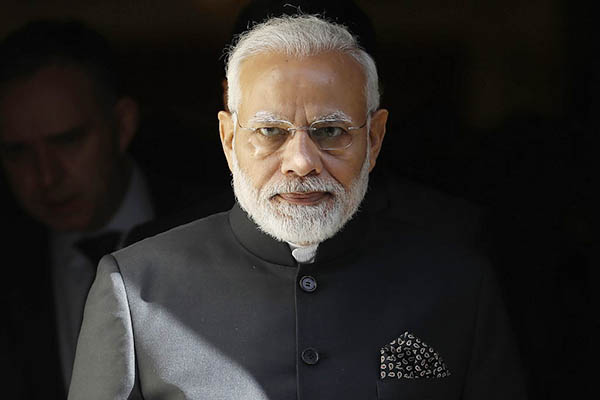
File photo. Tolga Akmen—AFP
Narendra Modi’s actions have prompted South Asian nations to opt for Chinese investment to India’s detriment
In the new world order, Samuel Huntington asserts, no country has “global security interests,” including the United States. “The world will be ordered on the basis of civilizations or not at all,” he says; peace will only exist if the core states representing different civilizations can respect others’ sphere of influence. What happens is that civilizational spheres of influence in which there is a core state, such as China, the U.S., or Russia, that state (with consent) dominates those within the sphere. Yet these spheres only work if there is a cultural affinity with the core state. Pakistan, Sri Lanka, and Bangladesh will not accept India as their core state and order provider, for instance, and similarly no country sees Japan in this role because culturally it stands on its own.
According to Indian media, Prime Minister Sheikh Hasina of Bangladesh has stopped meeting India’s high commissioner and the pace of all Indian projects in Bangladesh has slowed down since her re-election in 2019. Dhaka is currently focused more on Chinese infrastructure projects, and has awarded an airport terminal construction contract in Sylhet to a Chinese company, ignoring India.
Seeing what is happening, Prime Minister Imran Khan got on the phone with a heretofore offended Hasina, saying: “Pakistan is committed to deepening fraternal relations with Bangladesh on the basis of mutual trust, mutual respect and sovereign equality.” He was somewhat relieved on the western front too, where India was dominant not long ago and not averse from doing mischief inside Pakistan.
Iran, put off by India’s delay in completing the funding of Chabahar Port, has also let China in, signing a big program of development with Beijing worth $244 billion. Surprisingly, Abdullah Abdullah, the head of the High Council for National Reconciliation of Afghanistan, and an old friend of India, was reportedly planning a visit to Pakistan “as part of his efforts to improve bilateral ties between Afghanistan and Pakistan.”
India is behaving oddly in the region after firming up its relationship with the United States under Donald Trump, who somewhat resembles Narendra Modi’s aggressive behavior in South Asia, clashing with China and giving a tough time to its smaller neighbors like Pakistan, Nepal and Bangladesh—all three now understandably finding China a more attractive partner. Nepal complains of territorial trespass, Pakistan complains of firing across the Line of Control that kills innocent Pakistanis, and Bangladesh is greatly disturbed by Modi’s National Register of Citizens (NRC), as applied to the northeastern state of Assam bordering Bangladesh. Under its present state, the NRC would drive millions of Muslim Bengalis from Assam into a Bangladesh already burdened with over 900,000 Rohingya Muslim refugees fleeing oppression in Myanmar.
India doesn’t like her three neighbors’ economic ties to China as it initiates its own “a la Trump” anti-China policy in the region. To the west of Pakistan, Modi seems to be choosing sides too, now that it becomes clear that America will leave the Gulf region and would not like China to fill the power vacuum there on the basis of its regional economic dominance. China would have the facility of two ports for the transfer of its goods to the region: Pakistan’s Gwadar and Sri Lanka’s Hambantota, which it now owns after Sri Lanka’s failure to pay up. After offending Bangladesh with NRC, India will have China next-door in the east too doing projects similar to CPEC in Pakistan.
It is true that the Arab side of the Gulf is closer to India than to Pakistan despite the former’s religious affinities to the latter; and the relationship is entirely due to India’s technological advancement and the Gulf’s need to “diversify” from oil to investments abroad. Pakistan would have been the first choice for its Arab patrons had it not kept itself backward and blocked normal technology transfers by pursuing a jihadist policy.
Pakistan should be aware of the omens as it thinks about how to change tack and become “normal” for the world. It has been “non-provocative” to an aggressive India and has tried—without succeeding—to tone down an ideology that has damaged it. It opened up the Kartarpur Corridor for Indian visitors but tried and failed to build a Hindu temple in Islamabad because of the deeply entrenched ideological aggression in its guts. Totally oblivious of what is transpiring in the region it has started a campaign of brainwash in its largest province Punjab, allowing semi-literate bureaucrats to ban textbooks containing references to religions other than Islam.
Observers who visit a Hindutva-ridden India are amazed at how it has become like the very country it has hated over the years—Pakistan—bothering it over Kashmir and with jihadi adventures like the Mumbai and Indian parliament attacks through “deniable” terrorists. The scenario today is a China-U.S. contest in the region with India choosing to play the role of America’s proxy. The contest is not easy to predict, as China would have to deal with relatively primitive partners like Pakistan where “modern medievalism” has made all “correction” of the state impossible.
